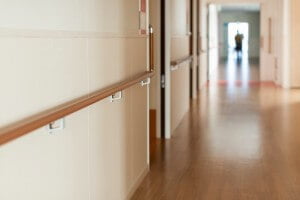Nearly All High-Touch Surfaces in LTC Test for Fecal Contamination
Posted on behalf of Jeff Pitman on February 18, 2022
in Nursing Homes and Elder Rights
Updated on September 7, 2024
 A study released on Thursday revealed that over 90 percent of high-touch areas in long-term care facilities are contaminated. These areas, including handrails, equipment controls and other common surfaces, showed evidence of fecal matter and other infectious disease sources.
A study released on Thursday revealed that over 90 percent of high-touch areas in long-term care facilities are contaminated. These areas, including handrails, equipment controls and other common surfaces, showed evidence of fecal matter and other infectious disease sources.
PKSD shares more about these disturbing findings and how researchers conducted the study.
If you suspect your loved one has suffered harm due to nursing home negligence, we encourage you to contact us for legal help. Our knowledgeable nursing home abuse attorneys in Wisconsin are prepared to help, and our firm is available to take your call 24/7.
FREE Case Review. 414-333-3333
Research Evaluation Process
According to an article in McKnight’s Long-Term Care News, researchers tested for levels of microbial contamination using three different hygienic monitoring tools. Eleven South Carolina long-term care facilities were included in the study group. Over 30 high-touch surfaces were evaluated in each facility for:
- Adenosine triphosphate (ATP) – reveals the presence of organic (fecal) material.
- Norovirus – indicates sources for infectious disease spread are present.
- crAssphage – indicates the presence of past or present fecal contamination.
This study was the first to use crAssphage in a long-term care facility to determine the presence of fecal contamination.
What the Study Revealed
In all, 337 high-touch surface areas were tested. Of those areas, ninety percent were positive for fecal matter or had failing ATP cleanliness scores.
Broken down more specifically, the study showed:
- crAssphage – often at high levels – on 311 surfaces, or 92.3 percent
- ATP at failing to high levels on nearly all tested surfaces, or 98 percent
- Norovirus – All 337 (100 percent) of targeted areas tested negative for norovirus. This result is consistent with prior studies which suggest noroviruses are seldom detected in the absence of a current or recent outbreak.
After analyzing the data, researchers identified specific surfaces most likely to be contaminated with organic or fecal matter:
- Handrails and equipment controls
- Patient bed handrails
- Tables and chairs in patient lounges
- Hallway areas (including handrails)
In all, surfaces touched by visitors and patients were twice as likely to have ATP contamination when compared to areas mostly touched by nursing and/or janitorial staff – or just patients.
Could These Findings Help Improve LTC Sanitation Practices?
The results of the study, which were published in the American Journal of Infection Control, revealed valuable information. Long-term care facilities could use these findings to better monitor their cleaning. In turn, better hygiene practices could help to protect patients from severe diarrheal illnesses.
PKSD. On Your Side. 414-333-3333






